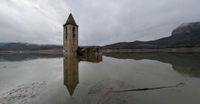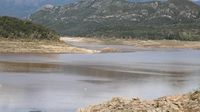The recent rainfalls in Catalonia have brought a tremendous change to the water reservoirs, marking a significant moment in the context of a persistent drought. As of March 20, 2025, reservoirs within the internal basins of Catalonia have reached 50% of their capacity for the first time since July 2022—a level not seen in 987 days. This improvement comes as a result of multiple rain events that occurred throughout March, including heavy rainfall from the Jana storm earlier this month.
For context, the reservoirs only held 216 cubic hectometers of water at the start of March 2025, equating to just 31% of capacity. Thanks to the recent rain, this figure has risen to 347 cubic hectometers—an impressive jump of nearly 18 percentage points in just two weeks.
The largest contributor to this increase has been the Baells reservoir, now boasting an impressive 82% of its capacity, a remarkable climb from 54% at the beginning of the month. Similarly, the Sau reservoir has expanded from only 6.7% to exceeding 40% in a matter of weeks. Meanwhile, in the Alt Empordà region, the Darnius-Boadella reservoir has surged from 17% to approximately 45% during the same period.
As reported by the Agència Catalana de l’Aigua (ACA), these reservoirs play a crucial role in supplying water to the provinces of Barcelona and Girona as well as the Solsonès region. The Ter-Llobregat system, which includes five main reservoirs—Sau, Susqueda, Baells, Llosa del Cavall, and Sant Ponç—has significantly improved the water situation in the province.
No longer in an emergency phase due to drought, certain municipalities previously struggling have now officially exited this state. Some additional reservoirs have shown noteworthy increases too. The Foix reservoir is now completely full, while Riudecanyes has reached nearly 38%, and Siurana is at 16%—both improving significantly from earlier lows.
However, while the current numbers are encouraging, officials remind us that there is still some way to go. Projections indicate that the reservoirs must reach around 75% capacity by June for a stable supply through the upcoming summer months. The overall situation reflects the positive impact of this month’s rains; with more than 200 liters per square meter recorded in key areas, conditions are looking hopeful.
Furthermore, in the Pyrenees, there is still over a meter of snow, which promises further water input as it melts. With experts emphasizing this as a pivotal moment, the question remains: are the drought challenges truly over for Catalonia? Even as the reservoirs improve, the past three years of hardship linger in the collective memory.
To better understand this rebound, it’s essential to recognize that just last year these very reservoirs were perilously low. In early March 2024, reserves plummeted to below 15%, which prompted the necessary emergency phase for the Ter-Llobregat system. A year later, the situation reflects both a recovery and a reminder of the resilience needed in water management.
Given that historical perspective, the regional authorities and the citizens of Catalonia remain vigilant. As the spring unfolds, forecasts suggest additional precipitation will continue to support these crucial water systems. It fosters cautious optimism that while the situation has improved, ongoing efforts in conservation and water resource management remain vital.
In conclusion, Catalonia’s water reservoirs have made impressive strides toward recovery, but as they hover close to halfway capacity, the region must remain proactive to ensure sustainability moving forward. The management of these resources is crucial, especially in the face of climate challenges that may lie ahead.







